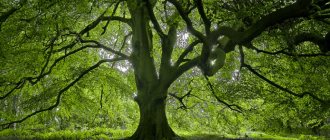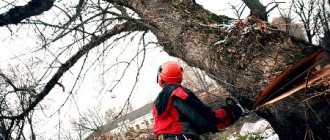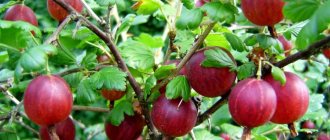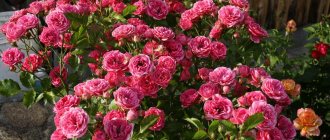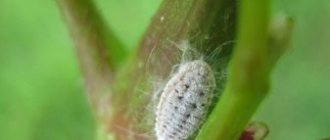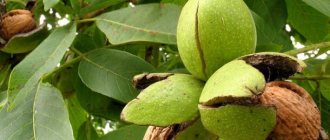Fruit trees with fast growth
A garden in the usual sense implies the presence of fruit trees. Every spring, areas with fruit varieties delight with beautiful blooms and aroma. But the main merit of such plantings is the summer or autumn fruit harvest . It can be:
- Apricot. The results of modern selection are frost-resistant and productive varieties. On average, an apricot tree produces an annual growth of 1−1.5 m in height. Most varieties are medium-sized trees. The fruiting period begins at 4-5 years. In southern latitudes, apricots can bear fruit within 3 years.
- Plum. Trees can be either low-growing - 2.5-3 m, or tall - up to 5 m. Popular varieties of plum trees are resistant to frost, drought, diseases and pests. The fruits are yellow, red, dark blue. In productive years, from 40 to 70 kg of fruit can be removed from mature trees per season. Plum grows very quickly and pleases with the first harvests already in the 3rd year.
- Cherries. New modern varieties make it possible to quickly grow and obtain good harvests of cherries even in central Russia. Trees grow to maturity in 4-5 years. From the same age, they begin to bear fruits of 15-25 kg on average from each tree during the summer season. Mature trees are resistant to rot, temperature changes, frost and consistently produce crops for 20 years.
- Quince. This is an unpretentious, fast-growing tree in the southern regions, on sandy and clay soils. Its growth is 1.5 m per year. The maximum height is 7 m. Industrial varieties bring large yields. The fruits are found in the shape of an apple or pear, yellow in color, with firm and very aromatic pulp. The weight of one fruit is from 400 g to 2 kg.
- Walnut. Grows in southern latitudes. It stands out for its rapid growth - up to 1.5 m per year, significant crown height - 15-25 m and trunk diameter up to 1.5 m. These are centuries-old trees with a powerful branched root system. They bear fruit between 5 and 100 years of age.
Ornamental trees for small areas
It is especially important to choose the right trees for small areas. After all, as they say, every meter counts. Who wants to plant trees, care for them, and then regretfully cut them down or cut them down when it suddenly turns out that instead of the promised dwarf or low variety, a tree with a crown width that covers half the plot has grown. All the seedlings seem small, and it seems that they will grow for a long, long time. Unfortunately, there are also very fast-growing species, and trees with a powerful root system and root suckers, which then have to be specially disposed of. Now there are no problems choosing low species and varieties for small areas. Recently, a huge number of varieties have appeared on the market, so diverse in shape and color that it makes your eyes run wild. Here are ornamental trees that are perfect for small and medium-sized garden plots.
- Warty birch variety “Youngii” is a very decorative tree with a weeping crown resembling an umbrella. This variety grows slowly. The height and width of the tree is up to 6 meters. It will look good in small gardens, near ponds and reservoirs, near terraces and patios. Winter hardiness zone 3, up to – 40ºС.
Rafael Lopez / Flickr.com
- Warty birch "Gracilis" is a beautiful tree with an airy and delicate hanging crown. It grows slowly, by the age of 20 it grows to only 5 m. Winter hardiness zone 2, up to -45.5ºС.
- False sycamore maple “Esk Sunset” is a low tree with a round crown shape. Very interesting leaf color, can be yellow, pink or cream with various spots of rich green color. The leaves are purple on the underside. The variety is slow growing. Winter hardiness zone 5A, up to – 28.8ºС.
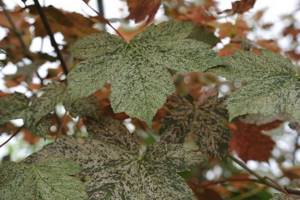
Megan Hansen / Flickr.com
- Aralia is tall - the tree itself is small, but its leaves are very impressive. The crown of Aralia is free, umbrella-shaped. The branches are covered with short spines. The leaves are very decorative, up to 100 cm in length, turning yellow in autumn. The tree grows up to 5-8 m in height. Winter hardiness zone 5A, up to – 28.8ºС.
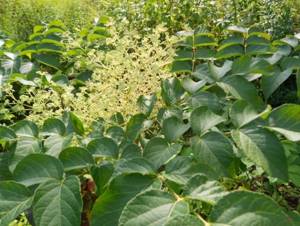
Kuleshova Natalya / Myproplants.com
- Japanese crimson "Rotfuchs" is a short tree, with a rather narrow vertical crown and beautiful leaves. Reaches 5 m in height with a diameter of 1 m. In spring, dark purple leathery leaves open, which then acquire a slightly bluish tint. In autumn, the foliage turns a rich, bright crimson color. It will grow well in damp areas without stagnant moisture. Prefers places well protected from the wind. Winter hardiness zone 5B, up to -23.4ºС.
- Beech "Purple Fountain" is a tree with drooping branches and the same drooping top. The leaves of the plant are dark, red, shiny, and turn yellow in the fall. Choose protected landing sites. The soils are suitable fertile and nutritious. Winter hardiness zone 5B, up to -23.4ºС.
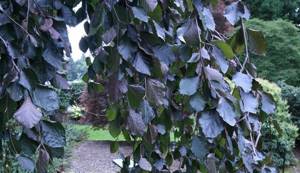
Gardening Solutions / Flickr.com
- Beech "Purpurea Pendula" is a tree with a weeping crown, shaped like an umbrella. The leaves are deep red. A beautiful scenic element to a small garden for contrast. Winter hardiness zone 5B, up to -23.4ºС.
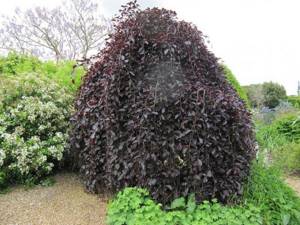
Leonora (Ellie) Enking / Flickr.com
- Common ash "Crispa" is a dwarf variety with an amazing appearance. At the age of ten it reaches only 1.5 m in height. The crown is not voluminous, dense, irregular. The branches are thick, hard and upright. The leaves are small, curly, densely spaced. Winter hardiness zone 4, up to – 34.4ºС.
- Swamp oak "Green Dwarf" is a slow-growing standard form. By the age of 10 it reaches 1.5 m in height. The leaves turn wine red in autumn. Winter hardiness zone 5B, up to -23.4ºС.
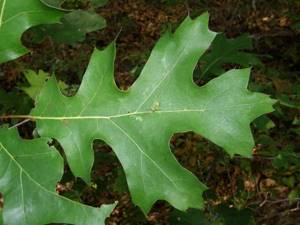
Rafael Medina / Flickr.com
- English oak "Pectinata" is an interesting slow-growing variety, barely reaching 4 m in height after 30 years. The leaves seem to be cut into narrow strips. Loves moist and rich soils. Winter hardiness zone 5A, up to – 28.8ºС.
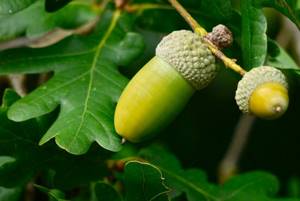
Rita Willaert / Flickr.com
- Willow Matsudana "Erythroflexuosa" is a low, slow-growing variety with a dense, ball-shaped crown. By the age of 20 it will reach 4 m in height. The branches of the tree are decoratively curved, with red-orange bark, and are used in floral compositions (Salix). Loves neutral soils. Annual pruning is required. Winter hardiness zone 5B, up to -23.4ºС.
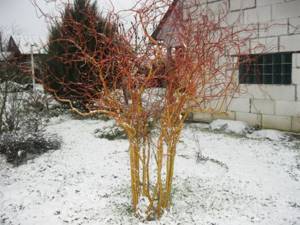
Shestak Angelika / Myproplants.com
- Mountain ash "Pendula" is a plant with drooping, crooked branches. The height of the tree depends on the height of the grafting site. Undemanding to soils. It will decorate the garden both during flowering and when it bears fruit, and in the fall the foliage turns yellow or orange. Winter hardiness zone 3, up to – 40ºС.
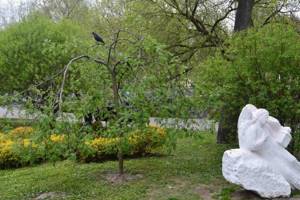
Komendantova Natalya / Myproplants.com
As you can see, the choice is quite large, and this list of beautiful ornamental trees for small areas could go on and on. The choice is yours. Don't give up on beautiful trees that will really decorate your garden or area. You just need to know which varieties are right for you, and you will never be disappointed with your choice. Let the trees bring you only joy in your garden.
"High-speed" hardwoods
You can quickly green up a park area, alley, sanitary protection strips, and recreational areas by planting seedlings of deciduous trees with rapid growth. Owners of homestead territories and summer cottages use these types of vegetation to obtain dense greenery and abundant shade. Some varieties take root well and grow so quickly that after just a couple of years they look like powerful, mature trees.
Among them are the following breeds:
- Acacia. There are tree-like and tree-shrub forms. The species suitable for the middle zone is white acacia. It has a powerful root system that supplies the plant with water during drought, branched trunks with thorns, characterized by rapid growth, up to 1.5 m per year. Decorative and fragrant acacia flowers are collected in large tassels. Acacia is considered a weed, rapidly spreading by self-seeding, and a fast-growing tree. Every season, the area closest to the tree is filled with new thorny seedlings.
- Willow. It has many varieties with leaves of different shapes and shades. It takes root very easily and within a year grows into an almost adult tree 2.5 m tall. It has a spreading, curved crown and perfectly decorates artificial and natural reservoirs.
- Poplar. The poplar belongs to the fast-growing willow family. There are more than 100 species of poplars, both natural and hybrids. Trees quickly grow up to 30 m. Many species grow old and die after 20 years. Poplars have a peculiarity: “female” trees during the flowering period (May, June) spread fluff, which causes unpleasant symptoms in allergy sufferers.
- Maple. There are about 150 species of maple shrubs, tall and dwarf maple trees around the world. No more than 30 species are common in Russia, of which the most popular in the central part of the country is the holly or sycamore. Its growth rate with proper care and suitable soils is up to 2 m per year. Maple is famous for its carved leaves of various colors. The decorative form 'Crimson King' has impressive red-brown leaves, 'Crimson Sentry' has purple leaves, and 'Globosum', often found in European countries, has bright green leaves.
- Birch. The fastest growth is observed in the warty birch species - 2 m per year. The tree grows up to 25−30 m in height. The trunk of young seedlings is brown, after 8 years the bark turns white. The crown has a spreading shape, the branches bend strongly downwards.
Olga Sobachkina
The problem with new garden plots is often the absolute lack of shade. This is especially inconvenient if there are small children for whom playing in the open sun is simply dangerous. A full-fledged garden will begin to form after about five years, so let's look at what can be done to quickly create shade on the site.
Gazebos
The simplest thing is to install a temporary summer gazebo made of dense material. There are many types of such gazebos, they vary in size and appearance. It is cheaper to buy a tent in the fall, when sales begin in stores. For the winter, it is advisable to disassemble the structure and take it indoors.

You can install a permanent gazebo on a foundation to the size needed by your family and consistent with the design of the house. Material: wood, stone, polycarbonate on a metal base. We wrote about how to choose the size of a gazebo for your garden in this article.
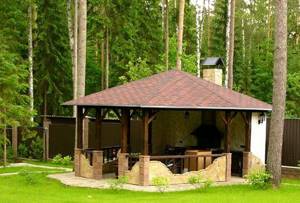
Canopy
The most economical way is to arrange a temporary shed . You can make it yourself using wire and thick fabric. A fence, the wall of a house, a barn, or specially constructed beams are suitable as a point for attaching the wire. Ready-made canopy structures with supports are sold in stores. The simplest of them is a beach umbrella. The disadvantage of such structures is their lack of stability in windy conditions.
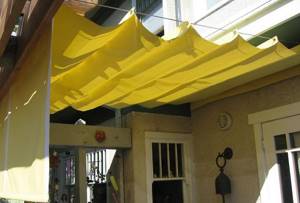
The following options already use plants.
Canopies and arches with vines
Prefabricated and inexpensive structures of arches, canopies, and pergolas can be supplemented with climbing plants. As a rule, they grow very quickly, develop along the proposed support, and have dense foliage that creates high-quality shade.
Of the liana-like plants, the most unpretentious and fast-growing are: five-leaved maiden grape, Amur grape, Brown's honeysuckle, petiolate hydrangea, actinidia Kolomikta.
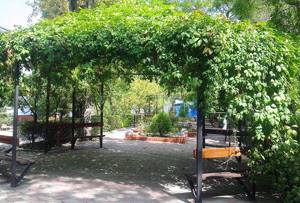
The bonus from planting such vines, in addition to good shade, will be:
- Amur grapes have tasty fruits reminiscent of the “Isabella” variety,
- hydrangea and honeysuckle have beautiful abundant flowering,
- Maiden grapes have a rich autumn color (from orange to purple),
- Actinidia has fruits rich in vitamin C (many times more than in sea buckthorn).
The downside of vines is their abundant spread of tendrils and root shoots; fertile soil nearby will always attract them to send out their shoots there. If there are bushes or trees along the way, they will happily use them as support. If you provide them with a building wall as a support, then they will gradually destroy its structure, since they are able to penetrate both wood and concrete.
It would be optimal to grow vines on specially prepared trellises made of wood or metal, directing the shoots in the desired direction and limiting growth in adulthood. You can read more about vines for the middle zone here.
“Growing shade” or which trees to plant in the garden for shade
And another option to quickly create shade on the site for a long time is to plant trees and shrubs that will quickly grow and, in addition to creating shade, will please the eye and decorate the garden.
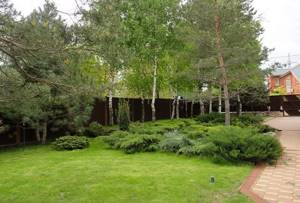
If you have a large garden , you are not limited in space and do not advocate growing exclusively useful fruit trees, you can plant the following fast-growing large trees :
- birch - a significant disadvantage is that it loves moisture and, as a result, sucks moisture from the soil from neighbors,
- white willow - weeping species are especially interesting, growth in favorable conditions is up to 2 m per year, prefers wet places,
- pine - gives a loose openwork shadow,
- common spruce - dense shade,
- elm - cases of elm disease with Dutch disease, which destroys the tree, have become more frequent,
- larch is a deciduous plant, provides good shade, but is not decorative in winter,
- eucalyptus, sycamore, pyramidal poplar - suitable only for warm regions, by the way, eucalyptus is considered the fastest growing tree on the planet (growth 4-5 m per year),
- linden - provides good shade, smells great during flowering, the flowers are healthy and can be brewed into tea,
- Manchurian walnut - grows very quickly, gives good shade, loves moist soils, taking excess water from them.
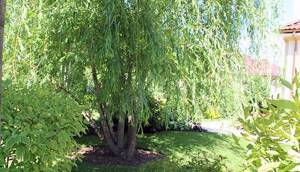
If you do not have a very large plot, then the large plant on the plot will look like a giant, stretching disproportionately above the rest of the plantings. Therefore, for small areas, you can pay attention to the following trees and shrubs that provide shade:
- low-growing varieties of willow, weeping species are interesting (if the common willow is cut from the top, it will grow like a shrub),
- Robinia is a fast-growing tree with magnificent fragrant clusters of flowers, a honey plant, undemanding to soil and moisture, recovers after freezing, has thorns on the trunk,
- Virginia bird cherry - blooms magnificently, has decorative purple leaves, bears fruit, but produces abundant root shoots, filling the space, loves moist soils,
- red elderberry - growth up to 1 m per year, beautiful bark, strong branching, repels flies,
- black elderberry - beautiful crown shape, needs fertile, loose, moist soil, without light the color of the leaves turns pale,
- Rowan - a beautiful slender tree with an openwork crown, will decorate the garden in winter with fruits and feed birds,
- viburnum - grows quickly, produces useful fruits, but is very loved by aphids, the “Buldenezh” variety is especially effective,
- hazel - has species with green and red leaves, forms a large bush, bears fruit in the presence of male and female plants,
- maples - there are many interesting species that decorate the garden in autumn and create dense shade; they prefer moist soils,
- acacia - there are interesting varieties, but it very much invades the area, like a weed, honey plant,
- quince - grows quickly, bears fruit, blooms beautifully,
- common hawthorn - grows best in sunny places and well-drained soils, the fruits are eaten,
- walnut - grows quickly, but turns green late, does not bear fruit in the middle zone,
- lilac - beautiful bloom and aroma,
- Canadian serviceberry - beautiful bush shape, sweet berries,
- Eleven angustifolia - silvery leaves,
- European euonymus is attractive with its bright autumn colors and unusual fruits. And also read:
Choosing plant seedlings for the gardenContainer gardening for patios, balconies and terraces
Fast growing conifers
Over the past decades, it has become popular to decorate front gardens, courtyards, and alleys with coniferous trees. They attract attention with their small leaves, unusual for the middle zone - needles and crown shape. They are often used to create a beautiful landscape composition. Conifers have a number of advantages. They are unpretentious, grow quickly, take root well, and do not require regular watering or crown formation.
The most common fast-growing coniferous species are:
- Larch. The only coniferous tree that turns yellow in the fall and sheds its soft needles, and young seedlings are covered with needles all year round. The crown is dense, cone-shaped. The tree is tall (up to 40 m), centuries-old (300-400 years or more), extremely resistant and unpretentious. Every year there is a growth of 1.5-3 m in height. Larch continues to grow even at 80 years old.
- Fir. The fastest growing species is the monochromatic fir. Branches with long gray needles begin close to the ground. The height reaches 40−50 m. Due to the fact that fir perfectly tolerates the polluted environment of city streets, the decorative variety “Kompakta”, the height of an adult plant of which is only 1.5 m, is often used for landscaping public gardens and monuments.
- Cedar. A very useful, unpretentious and fast-growing evergreen tree. The most popular variety is Siberian cedar. Grow from seeds or grafting cuttings onto pine trees. Seedlings are planted in a permanent place in groups of 3-4 pieces for pollination and harvest. To form low-growing trees, the crown is heavily pruned.
- Pseudotsuga (lying suga). This tree of the pine family is often confused with fir. She has the same long and gray needles. Another decorative property is large open cones. Pseudotsuga grows half a meter per year and can reach a height of 100 m in natural conditions. But for landscape design they prefer to plant low varieties: “Blue Wonder” - up to 5 m, “Holmstrup” - 3-8 m and “Mayerheim” - up to 10 m. The crown of young trees is cone-shaped, old trees are rounded from the sides and take on the shape of a barrel.
- Thuja. They belong to the cypress family of conifers, but instead of needles, thuja has soft evergreen scales. Thuja is often used as “green fences”, but it is quite beautiful when planted alone. There are two main varieties: eastern and western. The main difference is that Western thuja exudes a delicate aroma due to the abundance of essential oils and phytoncides. Annual growth averages 40−50 cm.
Tall coniferous trees are used for landscaping areas along the periphery. Low-growing ornamental hybrids are planted one at a time or in a group, anywhere on the site.
Choosing dwarf trees
Japanese maples are incredibly beautiful, but do not tolerate frost well and need shelter. Landscape designer Natalia DUDAREVA talks about the features of growing dwarf trees.
Which tree is better: low-growing or standard?
Low trees are obtained in two ways: by breeding dwarf forms and by grafting plants onto a standard. Dwarf and low-growing varieties are usually found in coniferous plants. Today you can easily buy seedlings of miniature pines, spruces, thujas, junipers, etc. Deciduous trees can also be made miniature - using special pruning techniques and growth regulation (similar to the art of bonsai). But, unfortunately, such trees take several years to grow and are very expensive.
As a rule, “dwarfs” need the same care as their tall “relatives” and like similar growing conditions.
Low-growing deciduous trees are often produced by grafting onto a standard. A standard is a plant of the same botanical genus as the graft, usually wild (wild forms are more resistant to frost, disease and other misfortunes). A branch of a delicate cultivated plant is grafted onto such a standard. For example, for wild plum - terry almonds. Accordingly, the plant will have a trunk-base from one tree, and a crown from another. The crown usually comes in different shapes, such as spherical, cubic, umbrella-shaped, and needs regular trimming.
Roses and berry bushes, grafted onto a trunk, look funny; they continue to grow in a clump, but raised from the ground by 1 - 2 m.
Please note that many standard plants are afraid of too cold winters, strong winds, and waterlogged soil.
Where will we plant?
Compact plants visually save space, so even in a very small area you can create a beautiful composition from them.
“Dwarfs” look good in groups of plants of the same species, but of different ages. Conifers trimmed with “balls” are especially decorative.
A group of weeping birch Jungi, pyramidal rowan of the Fastigiata variety and spherical Japanese maple looks win-win.
Miniature trees are well planted in compositions with shrubs, in rockeries (rocky gardens) and on an alpine hill.
Standard spherical forms are often used in symmetrical plantings around buildings, in alleys and along fences. They are especially combined with pyramidal trees and shrubs.
Rules of care
If your tree is a grafted form, be sure to ensure that shoots from the rootstock (standard) do not grow. As usual, they come from the buds of the trunk from the root or trunk. Buds on the trunk often appear in willow trees and almonds grafted onto plum trees. The shoots that run along the trunk must be broken out while they are green. Shoots from the root need to be cut out, penetrating into the ground as deeply as possible!
— All grafted “dwarfs” are not particularly demanding on the soil, but it is still recommended to replace the soil in the planting hole by 50%. The usual additives are sand, humus, mineral fertilizer, bottom peat.
When planting conifers, the soil in the planting hole is completely changed, the hole itself is dug large - miniature conifers have a well-developed root system.
To improve the appearance of the crown, you need to cut out all the shoots that change its characteristic shape. That is, those that grow upward from a weeping crown, or very strong branches that sharply and noticeably protrude beyond the boundaries of the even spherical crown.
Standard plants have little winter hardiness; they are covered by tying the grafted part and the bases of the branches with 3–5 layers of spunbond.
WHAT HOW MUCH
How much does a seedling cost?
Grafted (standard) forms are not cheap. Grown in a Russian nursery - from 2000 rubles, brought from abroad - from 3000 rubles.
Dwarf deciduous trees - from 300 to 700 rubles, coniferous trees - 500 - 700 rubles. For 400 rubles you will buy a tiny plant 20 cm tall. If you want to get “beauty” right now, buy an adult plant. But it can cost 10 - 15 thousand rubles, not counting the cost of qualified landing.
What varieties are suitable for the Moscow region?
Not all dwarf trees available for sale combine decorativeness with resistance to our climate. Here are the least demanding varieties.
Goat willow. An unpretentious but beautiful plant. If a branch is grafted onto a trunk with the buds down, a weeping form is obtained; with the buds up, a “bell” crown is obtained. "Bell" needs regular haircuts.
Pine Mops. Globular dwarf form, grows slowly. Loves light and partial shade, light but fertile soil. Tolerates the conditions of the Moscow region well.
Japanese maple. Plant on the south side, in a place protected from the wind, in rich soil. For this tree, frost below 25 °C is fatal, so the maple is covered for the winter. The tree is trimmed to give it shape.
Spruce Glauca Globosa. Bright blue, incredibly beautiful “ball”. 3 trees of different ages (and heights), planted in a group, look advantageous. This spruce loves sun and partial shade.
Thuja Aurea Nana. A dwarf variety with decorative golden-yellow needles, which turn bronze-green in winter. Thuya is suitable for well-drained garden soil and sunny or partial shade.
Rowan Fastigiata. The original columnar tree saves space on the site. Looks especially impressive in late summer/autumn with purple foliage and berries. Unpretentious, frost-resistant.
Weeping birch Yoongi. Grafted form, height depends on the height of the trunk. The branches grow downwards and outwards, the tree reaches 2 meters in height and 3-4 meters in width. An unpretentious, sun-loving plant.
Spruce Nidaformis. Shade-tolerant, grows up to 2 m in height. She feels quite well in the Moscow region and is easy to care for.
Milana BORISOVA
Fast growing shrubs
To create a harmonious landscape composition, it is better to separate tree plantings with shrubs. Among the shrubs there are also varieties with very active growth. Often shrubs are planted along fences, forming a hedge. You can create picturesque bush fences in just 1-2 seasons.
Types of shrubs with rapid vegetative growth:
- Barberry. This thorny shrub grows well in northern latitudes and is frost-resistant. The height of the bushes is on average 2 m. The leaves and shoots are green and purple. Produces sweet small fruits used for jam, compotes, and medicinal tinctures.
- Bladderwort. Planted along paths and fences. An unpretentious, fast-growing and densely growing shrub. It grows in height by 40 cm per year. Requires regular pruning. With uncontrolled growth it reaches 4 m in height and width.
- Snowberry. The honeysuckle family shrub grows successfully on all types of soils and is common in southern, temperate and northern latitudes. Tolerates drought and severe frosts. The height of the bushes reaches one and a half meters. It blooms throughout the summer, and in late autumn is covered with inedible white berries.
- Lilac. A popular shrub with an annual growth of 20 cm for low varieties and 40 cm for high varieties. The height of adult plants is 1.5−3 m. For faster development, lilacs need spring pruning. Varieties differ in shades of flowers and doubleness. All varieties, without exception, smell pleasant and quite intense.
- Hawthorn. The hawthorn bush meets all the requirements of landscape design. It can grow as a dense and impenetrable wall due to strong branching and an abundance of long thorns. Hawthorn does not grow very quickly at first, but after 3-4 years the growth rate reaches 60 cm per year. Not only hawthorn fruits are valuable, but also leaves, flowers and roots, which are used as raw materials for the production of medicines.
It is better to purchase seedlings from a trusted nursery or at specialized exhibitions. Experienced sellers and gardeners will always tell you which trees grow quickly.
Birch
The annual growth in height and width of some birches at the peak of their development can reach 1-2 m, so they may well top our list of the fastest growing trees in the middle zone. And if you think that birch is very ordinary and even boring, you simply have not seen its garden forms with extremely diverse types of growth, different types of crowns and unusual leaves - not only diamond-shaped jagged ones, but also narrow, openwork, deeply dissected ( almost like a maple), triangular, and also of different colors - from soft yellow to purple...
Among the fastest-growing, the most cultivated forms and varieties are found in the warty birch (silver birch, weeping birch) and curly birch.
Such birches quickly form a crown and increase the diameter of the trunk, live for a very long time and require pruning only during the dormant period.
These plants are generally very moisture-loving (not all, some tolerate periods of drought well), prefer the most illuminated places on a site with moderately acidic soil, are frost-resistant, resistant to diseases, bloom early in the spring, strengthen the soil (due to the large number of fine roots in the upper layers of soil).
- Planting birch trees in the country: 5 reasons
Is it worth planting a birch tree on the plot? We will name just a few reasons to prove the benefits of birch for humans.
Principles of landscaping
A harmoniously built landscape structure is one of the most important conditions for improving territories. In landscape design, several principles are used that take into account the properties of the site and the individual elements introduced into it. Knowing which trees grow quickly and which plants bloom lushly and abundantly, you can create separate zones that will perfectly complement and highlight each other.
When landscaping you should consider:
- plot size,
- plant growth rate,
- the size of adult plants,
- height of groundwater,
- soil quality,
- resistance of seedlings to frost and drought,
- combination of plants,
- smooth transitions of individual tiers.
When planning your landscape, you need to be patient. The growth and development of green spaces takes time and changing seasons. However, well-chosen fast-growing trees and shrubs will allow you to beautifully landscape any area in the shortest possible time.
Coniferous trees
If, pines, cedars and thujas retain a beautiful appearance even in severe frosts. They are very unpretentious, easy to care for, and grow long and slowly. They are often used to zone areas and create elegant evergreen areas.
Designers love to combine them with coniferous shrubs and create complete compositions that can delight the eye with their splendor. Coniferous trees scent the air and purify it. Why is it always easy to breathe in the area? Modern varieties boast needles of different colors and shapes. By playing with their combinations, it is possible to create a very interesting garden design.
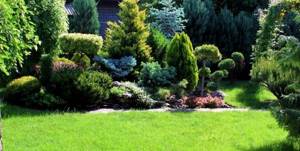
Beautiful coniferous compositions Source yandex.com
Tips on how to choose trees for landscape compositions
The main condition for choosing large-caliber plants is compliance with the general concept of garden design. It is important to take other indicators into account.
- In a well-created landscape design, trees correspond to the size of the site . You should not buy an oak seedling and plant it in a small garden. When it grows, it will turn into a giant, capable of covering all available space with its crown. Its roots will grow and take all the nutritional juices from the soil. This will negatively affect any other plantings.

Large trees can only grow in a large garden Source kak-peresadit.ru
- Each tree has its own growth characteristics . Decorativeness directly depends on the quality of the soil. If it is not suitable for the plants, they grow poorly. This also needs to be taken into account. There are soil amendments that help correct the situation. It is necessary to learn how to use them if there is a need to change the pH composition of the soil.
- Another important condition for choosing trees is the correct choice of planting location . There are sun-loving plants, and there are those that cannot stand direct sunlight. Some trees tolerate heat well and die in severe frosts. There is no point in planting branchy palm trees in central Siberia; it is clear that they will not be able to survive there. Conifers, on the contrary, grow poorly in southern latitudes.
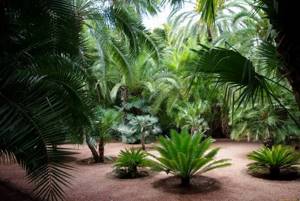
It is necessary to comply with the condition of compatibility of the color of the leaves and the shape of the crown with other landscaping elements. The beauty of classical architecture can be ideally emphasized by trees that have a strict crown geometry. To ensure that the overall design of the garden does not look like a chaotically planted area, it is important to designate all the trees on the landscape design plan. And then, when planting them, strictly adhere to the drawn up drawing.

